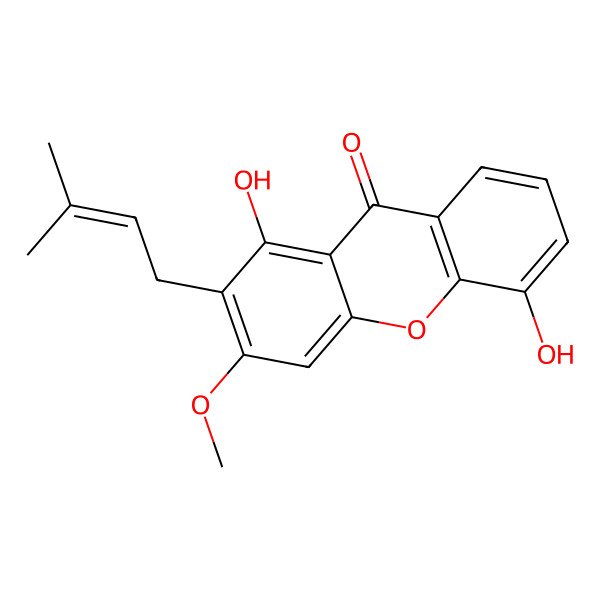1,5-Dihydroxy-3-methoxy-2-prenylxanthone
| Internal ID | b43647e0-7d0f-4bf5-b9e9-a777e882b44a |
| Taxonomy | Organoheterocyclic compounds > Benzopyrans > 1-benzopyrans > Xanthones > 2-prenylated xanthones |
| IUPAC Name | 1,5-dihydroxy-3-methoxy-2-(3-methylbut-2-enyl)xanthen-9-one |
| SMILES (Canonical) | CC(=CCC1=C(C=C2C(=C1O)C(=O)C3=C(O2)C(=CC=C3)O)OC)C |
| SMILES (Isomeric) | CC(=CCC1=C(C=C2C(=C1O)C(=O)C3=C(O2)C(=CC=C3)O)OC)C |
| InChI | InChI=1S/C19H18O5/c1-10(2)7-8-11-14(23-3)9-15-16(17(11)21)18(22)12-5-4-6-13(20)19(12)24-15/h4-7,9,20-21H,8H2,1-3H3 |
| InChI Key | INFMYEMPDJIILH-UHFFFAOYSA-N |
| Popularity | 8 references in papers |
| Molecular Formula | C19H18O5 |
| Molecular Weight | 326.30 g/mol |
| Exact Mass | 326.11542367 g/mol |
| Topological Polar Surface Area (TPSA) | 76.00 Ų |
| XlogP | 4.70 |
| 1,5-Dihydroxy-3-methoxy-2-prenylxanthone |
| CHEMBL1224332 |
| Gudraxanthone |
| SCHEMBL2054113 |
| CHEBI:175157 |
| DTXSID301317524 |
| 1,5-dihydroxy-3-methoxy-2-(3-methylbut-2-enyl)xanthen-9-one |
| BDBM50325679 |
| 1,5-dihydroxy-3-methoxy-2-(3-methylbut-2-enyl)-xanthone |
| 1,5-Dihydroxy-2-(3-methyl-2-butenyl)-3-methoxy-9H-xanthen-9-one |
| There are more than 10 synonyms. If you wish to see them all click here. |

| Target | Value | Probability (raw) | Probability (%) |
|---|---|---|---|
| No predicted properties yet! | |||
Proven Targets:
| CHEMBL ID | UniProt ID | Name | Min activity | Assay type | Source |
|---|---|---|---|---|---|
| No proven targets yet! | |||||
Predicted Targets (via Super-PRED):
| CHEMBL ID | UniProt ID | Name | Probability | Model accuracy |
|---|---|---|---|---|
| CHEMBL5619 | P27695 | DNA-(apurinic or apyrimidinic site) lyase | 99.37% | 91.11% |
| CHEMBL2581 | P07339 | Cathepsin D | 96.96% | 98.95% |
| CHEMBL3192 | Q9BY41 | Histone deacetylase 8 | 95.71% | 93.99% |
| CHEMBL3401 | O75469 | Pregnane X receptor | 94.97% | 94.73% |
| CHEMBL3108638 | O15164 | Transcription intermediary factor 1-alpha | 94.16% | 95.56% |
| CHEMBL1806 | P11388 | DNA topoisomerase II alpha | 94.14% | 89.00% |
| CHEMBL4203 | Q9HAZ1 | Dual specificity protein kinase CLK4 | 93.70% | 94.45% |
| CHEMBL2635 | P51452 | Dual specificity protein phosphatase 3 | 93.52% | 94.00% |
| CHEMBL1293249 | Q13887 | Kruppel-like factor 5 | 93.51% | 86.33% |
| CHEMBL4261 | Q16665 | Hypoxia-inducible factor 1 alpha | 91.12% | 85.14% |
| CHEMBL1937 | Q92769 | Histone deacetylase 2 | 91.10% | 94.75% |
| CHEMBL3060 | Q9Y345 | Glycine transporter 2 | 89.49% | 99.17% |
| CHEMBL3038477 | P67870 | Casein kinase II alpha/beta | 88.99% | 99.23% |
| CHEMBL2535 | P11166 | Glucose transporter | 87.98% | 98.75% |
| CHEMBL1075094 | Q16236 | Nuclear factor erythroid 2-related factor 2 | 86.02% | 96.00% |
| CHEMBL1163101 | O75460 | Serine/threonine-protein kinase/endoribonuclease IRE1 | 85.52% | 98.11% |
| CHEMBL1951 | P21397 | Monoamine oxidase A | 84.20% | 91.49% |
| CHEMBL3091268 | Q92753 | Nuclear receptor ROR-beta | 84.15% | 95.50% |
| CHEMBL2373 | P21730 | C5a anaphylatoxin chemotactic receptor | 83.61% | 92.62% |
| CHEMBL5608 | Q16288 | NT-3 growth factor receptor | 83.43% | 95.89% |
| CHEMBL4306 | P22460 | Voltage-gated potassium channel subunit Kv1.5 | 81.65% | 94.03% |
| CHEMBL3194 | P02766 | Transthyretin | 81.33% | 90.71% |
| CHEMBL4793 | Q86TI2 | Dipeptidyl peptidase IX | 80.91% | 96.95% |
Below are displayed all the plants proven (via scientific papers) to contain this
compound!
To see more specific details click the taxa you are interested in.
To see more specific details click the taxa you are interested in.
| PubChem | 10449043 |
| NPASS | NPC152951 |
| ChEMBL | CHEMBL1224332 |
| LOTUS | LTS0274706 |
| wikiData | Q105116184 |